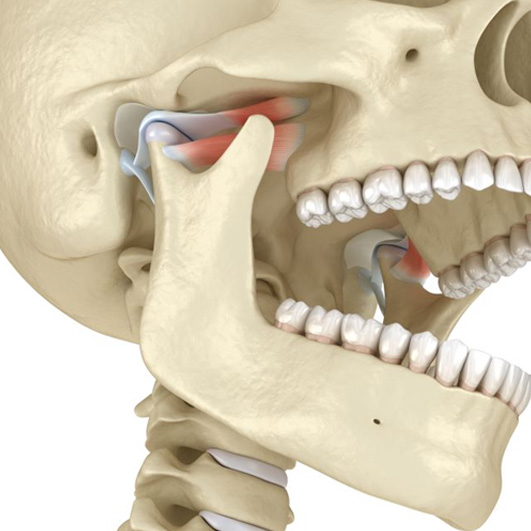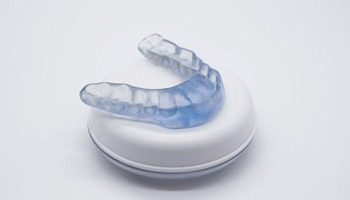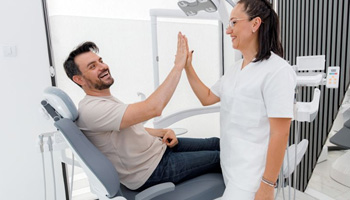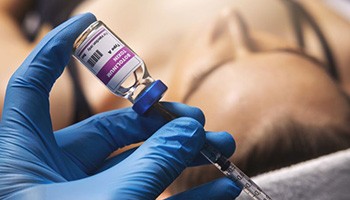Do you often experience jaw pain, headaches, and related symptoms? It is possible that you have TMJ disorder (TMD).
Since this condition is unlikely to resolve on its own, you should certainly seek professional care! Our Barnegat
team is ready to assist you with non-invasive, effective forms of TMJ treatment. Our goal is to find a lasting and
elegant solution for your jaw pain! Continue reading below to learn more, or contact us directly to request a consultation. We look
forward to serving you.
What Is TMJ Disorder?

Your temporomandibular joints (TMJs) are the joints located in front of each ear. They control movements of your
lower jaw. When these joints become damaged, inflamed, or injured, a broad range of symptoms can result.
Collectively, such issues are referred to as TMJ disorder (TMD), which is sometimes referred to simply as TMJ.
Untreated TMD can affect your ability to chew, speak, and carry out other essential tasks.
Symptoms of TMJ Disorder

There are quite a few symptoms that can occur as a result of TMD. Some of the most common include:
- Jaw pain or tenderness, often near the ears
- Frequent headaches or facial pain
- Migraines
- Clicking, popping, or grating sounds when moving the jaw
- Difficulty or discomfort while chewing
- Locking of the jaw, making it hard to open or close the mouth
- Earaches or ringing in the ears (tinnitus)
- Pain radiating to the neck or shoulders
Types of TMJ Treatment

Before we can determine which type of TMJ treatment best fits your situation, we will need to perform a thorough
examination. This may involve a visual exam and the use of imaging equipment, which can help us to get an inside
look at your teeth and jaw joints. We will also ask you to provide details about your symptoms.
Once we get a better understanding of the situation, we may recommend certain home remedies, such as dietary
changes
or hot/cold therapy. One of the following professional treatments may also be necessary to optimize your
results:
Occlusal Splint

An occlusal splint is a custom oral appliance that helps to prevent teeth grinding, which is a major contributor
to
TMD. It can also slightly reposition the lower jaw and help the surrounding muscles to relax. With consistent
use,
many patients experience long-term symptom relief thanks to their occlusal splint.
Equilibration/Occlusal Adjustment

Imbalances in your bite might be contributing to your condition. To address this, we may make minor modifications
to
the surfaces of your teeth and/or restorations. This can help your upper and lower teeth to work better
together,
resulting in reduced stress on your TMJs.
BOTOX for TMJ Treatment

BOTOX is most famous for its cosmetic applications, but did you know that it also has some amazing medical uses? In fact, it can be a useful means of relieving TMD symptoms. When it is strategically injected near the jaw, it can force overworked muscles to relax. This can result in a significant reduction in pain. BOTOX is usually combined with other TMJ therapies as part of a comprehensive treatment plan.
Read More
What Is BOTOX?

BOTOX is the brand name of a diluted form of bacteria known as botulinum toxin. When it is strategically injected into facial muscles, it limits their movements and forces them to relax. This is the power behind BOTOX’s ability to fight wrinkles; when the muscles are relaxed, the skin on top of them does not move as much, and it can look much smoother.
Forcing the muscles to relax can also relieve tension and pain throughout the area around the jaw, leading to big-time symptom relief. A BOTOX treatment session is brief, the results should start to become apparent within several days, and you may experience pain relief that lasts for months at a time.
Are You a Good Candidate for BOTOX for TMJ Treatment?

You might be a candidate for BOTOX as a TMJ treatment if you often experience symptoms of TMD, such as jaw pain and tenderness, limited jaw mobility, popping and clicking in your jaw, headaches, and migraines. BOTOX can be especially helpful if your TMD is accompanied by bruxism (teeth grinding and clenching). When your muscles relax, you may be much less likely to unconsciously grind your teeth, which can spare your smile from damage and greatly reduce facial pain and stiffness.
Our team will consider the details of your case to determine if BOTOX is suitable for you.
How Can BOTOX Treat TMJ Disorder?

BOTOX has some impressive support as a treatment for TMJ disorder. In fact, a 2012 study found that this treatment significantly reduced the pain of mouth movement for three months after the injections. Another study noted that BOTOX improved 90% of participants’ TMJ symptoms.
Keep in mind, though, that BOTOX is primarily for pain relief. It does not address the root causes of TMD. That is why we often pair BOTOX with other approaches that are designed to manage the cause of symptoms and provide longer-lasting relief.
If you would like to learn how BOTOX may be able to help you, our team would be happy to answer your questions and design a custom TMJ treatment plan. Hopefully, you will soon be on your jaw to a pain-free jaw.
TMJ Treatment FAQs
Is it possible to cure TMJ disorder permanently?
The treatment possibilities for TMJ disorder, as well as their effectiveness, is largely dependent on the underlying causes of your condition. For example, a past injury may lead to chronic TMJ issues that can only be managed with treatments like an occlusal splint or BOTOX injections. However, if the underlying cause of TMJ disorder is a treatable issue like a bite problem or ill-fitting restorations, orthodontic treatment or occlusal equilibration can provide you with permanent relief.
How can BOTOX help with TMJ disorder?
Many patients aren’t familiar with BOTOX for TMJ treatment because their dentists often don’t offer it. With specific training in BOTOX administration for TMJ/orofacial pain trigger points, Dr. G is one of few dentists in the area who is knowledgeable and able to provide this fast relief for his patients.
When the injection is administered in the muscles surrounding the temporomandibular joints, the BOTOX will allow them to relax and smooth out, helping prevent many uncomfortable symptoms, like headaches and chronic jaw pain. Your results can last for several months before follow-up treatment is needed. This is the perfect temporary relief for patients who experience severe and chronic TMJ pain.
How long does TMJ treatment take?
This largely depends on the treatment you’re receiving. When wearing your occlusal splint regularly, you will likely notice relief from your symptoms within a few weeks of use. On the other hand, treatments like occlusal adjustment and BOTOX injections can provide you with more immediate results. BOTOX injections begin to take effect after a few days, with the most relief coming after two weeks of treatment, while occlusal adjustments can give you immediate relief!
Can TMJ disorder be treated without surgery?
At Nu Dental Barnegat, our top priority is to help you find relief without the need for surgical intervention. That’s why all of the TMJ treatment options that we provide are non- or minimally-invasive. However, if your situation warrants the need for surgery, Dr. G and our team can refer you to a specialist to ensure your health, safety, and that you find the care that you require.
Is TMJ treatment covered by insurance?
Our team at Nu Dental Barnegat is happy to help you navigate your dental insurance benefits to help you save on TMJ treatment. We’re in-network with a number of PPO dental insurance plans and are happy to file claims to maximize your benefits if you’re out-of-network. Our primary concern is providing you with the high-quality care you deserve.









